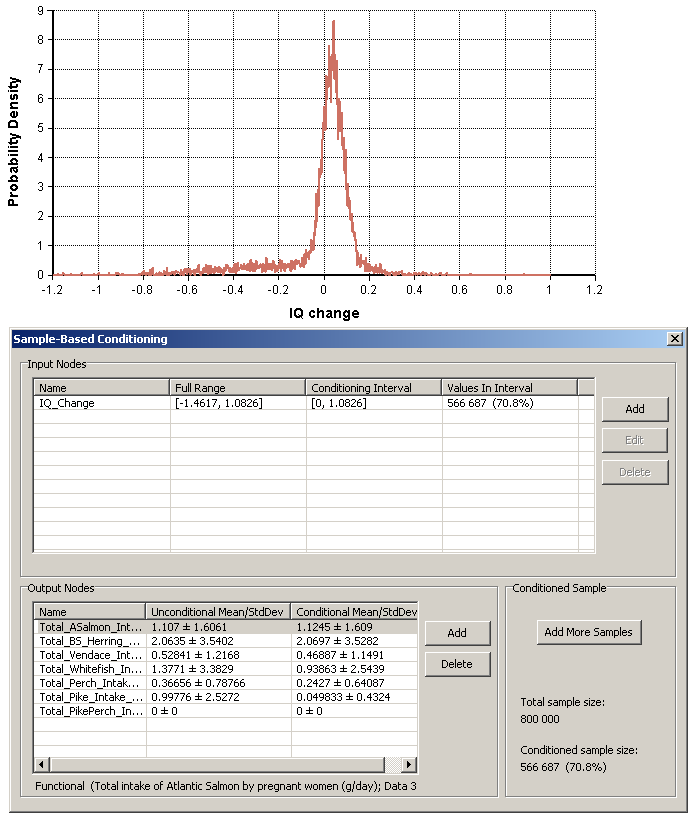Benefit-risk assessment of methyl mercury and omega-3 fatty acids in fish
| [show] |
|---|
| Main message: |
|---|
| Question:
What are the effects of methyl mercury and omega-3 fatty acids on development of intelligence quotient (IQ) in children? The source of exposure is Finnish fish consumption.
|
The Analytica model file contains the actual calculations for this assessment.
This project is planned to serve as a case study to represent the utilization of the open assessment method.
Scope
Purpose
What are the effects of methyl mercury and omega-3 fatty acids on development of intelligence quotient (IQ) in children? The source of exposure is Finnish fish consumption.
Boundaries
- Population of Finland
- Current situation
Scenarios
- Business as usual (the current situation).
- Total fish consumption is above the median.
- Total fish consumption is below the median.
- No fish consumption. R↻
Intended users
- Authorities giving food recommendations.
- Anyone interested.
Participants
- Beneris researchers, especially Olli and Patrycja Gradowska.
Definition
Decision variables
- Fish intake of pregnant mothers in Finland Unpublished data, requires a password.
Indicators
Other variables
Environmental variables
Exposure variables
- Domestic fish consumption of the pregnant women in Finland (unpublished data, requires a password)
- Fish oil intake in Beneris
- Methyl mercury intake from fish in Beneris
Population characteristics
- Body weight in Finland
- Baseline intelligence quotient (IQ) score in children
- Intelligence quotient (IQ) in children in Beneris
Exposure-response functions
Indices
- Fish (species): Herring, Vendace, Whitefish, Pike, Perch, Salmon, Pike-pearch
- Water (from which the fish comes from): Baltic Sea, Inland lake
- NOTE!
- Herring is only from the Baltic Sea.
- All pike-pearch is shown as "Inland lake" although a part comes from the Baltic Sea.
- All salmon is shown as "Inland lake" although most of it comes from the Atlantic Ocean from Norway.
Analyses
- What should be done to the total fish intake to keep the net effect of fish on the child's IQ positive?
- For the scenarios "total fish above median" and "total fish below median", what is the VOI for different variables?
Result
Results
NOTE! Average DHA and methylmercury exposure leads to zero impact compared with the background IQ.
The top graph shows the distribution of changed IQ in the child due to fish consumption of the pregnant mother in Finland (compared with the situation without any fish consumption). The lower graph shows the result of the first analysis: what should the fish intakes be to ensure that the IQ of the child does not decrease? The lower panel of the lower graph lists each species (leftmost column), the central column shows the intake of that species in the current situation, and the rightmost column shows the intake in the hypothetical situation where no IQ loss may occur. From the graph, it can be seen that to reach the objective,
- Atlantic salmon could be eaten more,
- there is no need to change the intake of Baltic herring,
- vendace, whitefish, and perch intakes could be slightly reduced during pregnancy,
- pike intake should be clearly reduced during pregnancy,
- there is not enough information to conclude anything about pike-perch.
The value of information analysis shows that for the decision "increase the total fish intake above the current median versus reduce it below the median", there is theoretically 0.02 IQ points per child to be gained if more information would be available. The further information needs are mainly about the most consumed fish species, namely herring and salmon. More should be known about both DHA and methyl mercury.
Conclusions
- The consumption of oily fish can be increased without a fear of detrimental effects of methyl mercury in the children. In contrast, the consumption of predator fish, especially pike, should be avoided during pregnancy.
- The case seems to be fairly well established, as the total value of additional information is fairly low.
See also
Fish-related assessments:
- Benefit-risk assessment of fish consumption for Beneris
- Benefit-risk assessment of methyl mercury and omega-3 fatty acids in fish
- Benefit-risk assessment on farmed salmon


